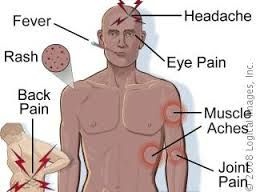What is dengue fever?
Dengue fever is a disease caused by a family of viruses that are transmitted by mosquitoes. It is an acute illness of sudden onset that usually follows a benign course with symptoms such as headache, fever, exhaustion, severe muscle and joint pain, swollen lymph nodes (lymphadenopathy), and rash. The presence of fever, rash, and headache (the "dengue triad") is particularly characteristic of dengue. Other signs of dengue fever include bleeding gums, severe pain behind the eyes, and red palms and soles.
Signs and Symptoms.
Dengue hemorrhagic fever is a more severe form of the viral illness. Symptoms include headache, fever, rash, and evidence of hemorrhage in the body. Petechiae (small red or purple splotches or blisters under the skin), bleeding in the nose or gums, black stools, or easy bruising are all possible signs of hemorrhage. This form of dengue fever can be life-threatening and can progress to the most severe form of the illness, dengue shock syndrome.
After being bitten by a mosquito carrying the virus, the incubation period ranges from three to 15 (usually five to eight) days before the signs and symptoms of dengue appear in stages. Dengue starts with chills, headache, pain upon moving the eyes, and low backache. Painful aching in the legs and joints occurs during the first hours of illness. The temperature rises quickly as high as 104 F (40 C), with relatively low heart rate (bradycardia) and low blood pressure (hypotension). The eyes become reddened. A flushing or pale pink rash comes over the face and then disappears. The lymph nodes in the neck and groin are often swollen.
Fever and other signs of dengue last for two to four days, followed by a rapid drop in body temperature (defervescence) with profuse sweating. This precedes a period with normal temperature and a sense of well-being that lasts about a day. A second rapid rise in temperature follows. A characteristic rash appears along with the fever and spreads from the extremities to cover the entire body except the face. The palms and soles may be bright red and swollen.
How can dengue fever be prevented?
The transmission of the virus to mosquitoes must be interrupted to prevent the illness. To this end, patients are kept under mosquito netting until the second bout of fever is over and they are no longer able to transmit the virus to a biting mosquito.
The prevention of dengue requires control or eradication of the mosquitoes carrying the virus that causes dengue. In nations plagued by dengue fever, people are urged to empty stagnant water from old tires, trash cans, and flower pots. Governmental initiatives to decrease mosquitoes also help to keep the disease in check but have been poorly effective.
To prevent mosquito bites, wear long pants and long sleeves. For personal protection, use mosquito repellant sprays that contain DEET when visiting places where dengue is endemic. There are no specific risk factors for contracting dengue fever, except living in or traveling to an area where the mosquitoes and virus are endemic. Limiting exposure to mosquitoes by avoiding standing water and staying indoors for two hours after sunrise and before sunset will help, as the Aedes aegypti mosquito is a daytime biter with peak periods of biting around sunrise and sunset. It may bite at any time of the day and is often hidden inside homes or other dwellings, especially in urban areas.



